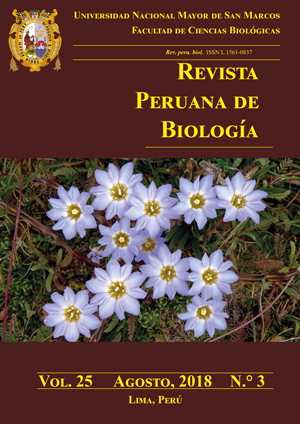Habitat selection and diet composition of Microlophus occipitalis (Reptilia: Tropiduridae) in Sechura, Piura – Peru
DOI:
https://doi.org/10.15381/rpb.v25i3.13403Keywords:
Habitat Use, Manly Selection Ratio, Reptiles Ecology, Ethology, Heliothermic Thermoregulation.Abstract
Microlophus occipitalis is a diurnal lizard distributed on the coasts of Ecuador and Peru, of which it is tried to determine the use and resources selection of habitat, as well as the main components of its diet. Survey was done in Napique lagoon (Piura, Peru), using the Design Type I of Manly (availability and use are estimated for all individuals of the species within the study area), and the Manly Selection Ratio to determine resources selection. The composition of the diet and amplitude of the trophic niche was analyzed with the standardized Levins index. A total of 1055 observations allowed determining that M. occipitalis selected the Trunk and Stone resources. The dominant activity was Food, followed by Sunbathe. There was a high consumption of Hymenoptera, followed by the Coleoptera. Microlophus occipitalis is a species that mainly uses the trunks and stones that occur in its habitat to be able to thermoregulate. Its main activity is food. It is a carnivorous species that in the spring-summer season consumes mainly ants and coleoptera but complements its diet with flowers and leaves in low quantity, in a seemingly accidental consumption.Downloads
Downloads
Published
Issue
Section
License

This work is licensed under a Creative Commons Attribution-NonCommercial-ShareAlike 4.0 International License.
AUTHORS RETAIN THEIR RIGHTS:
a. Authors retain their trade mark rights and patent, and also on any process or procedure described in the article.
b. Authors retain their right to share, copy, distribute, perform and publicly communicate their article (eg, to place their article in an institutional repository or publish it in a book), with an acknowledgment of its initial publication in the Revista Peruana de Biologia.
c. Authors retain theirs right to make a subsequent publication of their work, to use the article or any part thereof (eg a compilation of his papers, lecture notes, thesis, or a book), always indicating its initial publication in the Revista Peruana de Biologia (the originator of the work, journal, volume, number and date).






